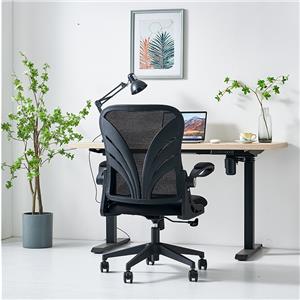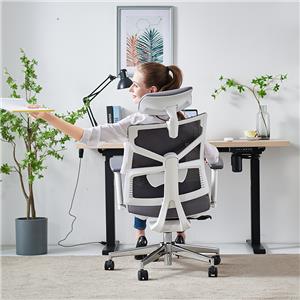Why do you need an ergonomic chair?
In recent years, whether it is news, self-media, or scientific research, the harm of sitting for a long time has been mentioned.
For example, prolonged sitting leads to obesity, hypertension and other diseases; prolonged sitting can affect people's memory and cognitive ability; sedentary people have a 40% higher risk of death than people who sit less; the risk of diabetes is 2.5 times that of people who sit less than people who sit less, etc. Wait.
1. Improper chair back and lumbar support cause lumbar muscle strain
When a person stands in a standard posture, the cervical vertebra, thoracic vertebra, lumbar vertebra and sacrum will show four normal physiological curves. In this state, the human body will feel the most relaxed, because the lumbar core muscle group and abdominal core muscle group in this spine shape are in balance, and there is no excessive stretch and contraction.
However, when we sit down, if we do not have proper chair back and lumbar support, the pelvis tends to tilt back, the cervical spine and lumbar spine turn from lordosis to kyphosis, the thoracic spine has greater kyphosis, and the force balance of the lumbar abdominal core muscle group is broken.
The back and waist muscles are stretched due to lack of support, and the abdominal muscles are contracted, which is equivalent to that the muscles are in a state of continuous passive exertion. After a long time, they will naturally feel sore and tired, which is why the waist muscles are strained.
The back and lumbar support of the ergonomic chair are designed according to the normal curvature of the human spine. You just need to lean on the back of the chair, and the back and lumbar support can provide proper support for the spine and help you easily maintain the normal curvature of the spine.
2. Inappropriate chair back angle causes lumbar disc herniation
Let's look at the force on the spine again. Assuming that we are in a standard standing position, the weight on the spine is 100kg (in fact, it is definitely not so large, for the convenience of explanation), when we sit in a standard sitting position, the pressure on the spine will reach 150kg.
In the posture of hunched over and working at a desk, the pressure on the spine can be as high as 180-270kg. Can you imagine what it would feel like to press a person heavier than yourself on your upper body when you were working at a desk?
Secondly, under normal conditions, the nucleus pulposus of the lumbar spine is in the middle of the intervertebral disc, and the force is even; when the body leans forward, the huge pressure on the spine squeezes the nucleus pulposus backward.
Over time, the lumbar intervertebral disc fibers will be destroyed, and will gradually bulge and protrude, resulting in the well-known lumbar intervertebral disc herniation, or even prolapse in more serious cases.
It can be seen from the above analysis that the most comfortable posture is undoubtedly lying down, but it is obviously impractical to work while lying down. Therefore, if you want to avoid problems such as lumbar disc herniation, you need an ergonomic chair with an adjustable back angle to help us maintain Slightly lean back to reduce pressure on the spine.
3. Unsuitable neck pillow causes cervical spondylosis
The cause of cervical spondylosis is basically the same as that of lumbar disc herniation. Working at a desk for a long time, as well as lowering your head and playing mobile phones, the cervical vertebra bears far more weight than the head.
The disc herniation in the cervical vertebra causes pain and numbness caused by the compressed nerve.
Most computer chairs are not equipped with neck pillows, or the neck pillows cannot be adjusted independently. The neck pillows of ergonomic chairs can be independently adjusted in height and angle to meet various needs such as sitting, leaning back, and lunch breaks.
4. Inappropriate cushions and armrests make it difficult to maintain a correct sitting posture
There are two round bones at the lowest end of the human pelvis, referred to as the ischium. According to the body pressure distribution curve, these two small ischial bones bear more than 75% of the weight of the upper body, and the rest of the weight is on the buttocks and thighs.
If the seat surface of the chair is too hard, the sciatic bones will fully bear more than 75% of the body weight. Over time, sciatica and other problems may occur.
However, if the seat surface is too soft, such as boss chairs or sofas, people will sink in, which will cause the femur to rotate upward and internally, the hip muscles will be compressed, and there are a large number of blood vessels and nervous systems at the bottom of the thigh. Blood circulation and nerve conduction, leading to numbness, edema and other problems.
At the same time, if the sitting surface is too soft and sags a lot, the inappropriate height of the armrest will increase the pressure on the elbows and shoulders, causing shoulder and neck pain.
The seat surface of the ergonomic chair can provide moderate elastic support for the hips and legs, avoid too soft or too hard, distribute the pressure to the greatest extent, and the height-adjustable armrest design can solve such problems well.




